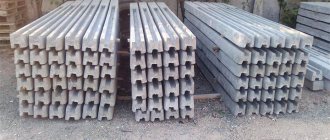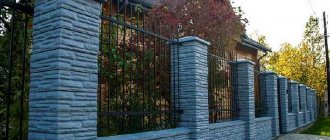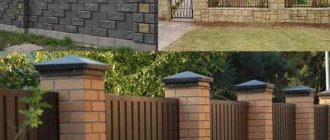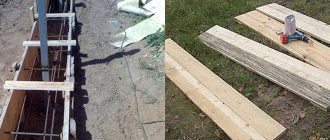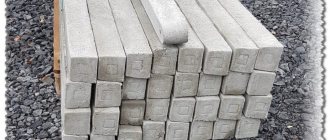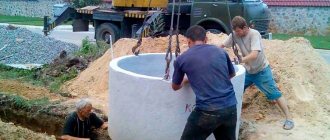A fence surrounding a house or cottage provides security, but also gives it a certain attractiveness. Therefore, it is important to choose the appropriate material for its installation. In this article we will talk about fence supports. The best option for this are concrete pillars, which give the fence stability and strength and are combined with various materials.
What concrete pillars are you thinking of using?
FactoryHomemade
There are two traditional options for concrete fence posts: factory-made and home-made. There is a difference between them. The quality of a factory product is higher than a handicraft one, although this is not a fact. But the fact that the industrial version is more expensive is clear. It is possible to make concrete pillars of various configurations at home, and if you buy or rent a vibrating table, the task is simplified several times.
Characteristics
It is worth saying a few words about the characteristics and features of concrete fence posts, what their pros and possible disadvantages are. So, the advantages of concrete pillars:
- Resistance to corrosion, dampness and temperature changes.
- Concrete pillars are massive, this quality makes them convenient for installation in the ground.
- Reliability and durability.
- Suitable for decorative processing, finishing with building mixtures, painting and processing with stone and tiles.
- Large selection of shapes and sizes.
- Easy to install, you can do without the involvement of specialists.
- Ease of internal wiring.
- Resistance to external weather and climatic influences, durability.
- Easy care.
Along with the undeniable advantages, we note some uncritical disadvantages:
- Installation requires preparation of the foundation, since without a good foundation the support loses balance and falls.
- Monolithic pillars are heavy. When purchasing in a store, there may be issues with loading and unloading, which will result in additional costs.
In the latter case, the solution would be to produce concrete pillars at home with your own hands. There are advantages here. The quality of the concrete is controlled and the product is manufactured even better than the factory one.
Requirements for fence posts and installation technology
On heaving soils, it is recommended to concrete the posts
. The main requirement for fence posts is durability. During operation, they must withstand the mass of spans and be resistant to dynamic loads. When designing a fence, it is necessary to provide a margin of safety so that it can withstand strong gusts of wind.
The choice of technology for installing fence supports is determined by the characteristics of the soil on the site. The reliability of the fence design depends on the depth of soil freezing and the level of groundwater.
- It is not recommended to concrete pillars installed in heaving soil.
- On hard soils it is better to hammer in the supports.
- Pillars are concreted in areas with sandy-clayey or sandy soil.
When constructing massive barriers, support pillars must always be concreted.
Manufacturing of formwork
This point is a determining factor in the manufacture of concrete fence posts, since the technical characteristics depend on it, because concrete requires compaction to remove air bubbles, which reduce strength. For this reason, manufacturing requires attention and care during assembly.
It is advisable to carry out operations with concrete in warm, dry weather. Otherwise, there may be a change in the composition of the uncured concrete solution, which will reduce the quality of the final product. There are two types of technology:
- Construction of the frame and pouring concrete immediately on site.
- Manufacturing of the support in another location and subsequent delivery to the installation site. This option is possible if there is a vibrating table on which the entire batch of supports is manufactured.
A simple and lightweight option is a wooden box. Thick plywood or planed boards are used, from which a box is constructed, open on both sides for pouring. The inner part is adjusted and covered with plastic film to prevent leakage. The wooden parts are connected with screws.
For round posts
Those who prefer support posts with a round cross-section make them themselves from HDPE pipes with a diameter of 15 cm. Moreover, they are much easier to produce. The pipe must be cut evenly vertically into two halves and ears or loops welded to them for subsequent connection and compression of both halves. Next, the solution is poured into the pipe and, after hardening, the finished profile is removed. Thus, the required number of concrete pipes is produced.
Box-shaped
This option is considered reliable and is assembled from three boards in the shape of a cone-shaped box with closed ends. It is possible to use waterproof plywood or sheets of plastic or metal. The cone-shaped box makes it easier to remove the frozen profile.
The inside is also covered with plastic film, which will protect the wood from getting wet and the solution from spreading. The pillars are made with section parameters of 150x200x200x200 mm.
Types of fence supports
Modern concrete is so diverse that it can easily compete with metal and brick in terms of service life. To make supports with your own hands, you should first of all stock up on cement of the appropriate brand with the necessary additives. Determine the place where you will work, tools, a concrete mixer, and make or purchase forms for the pillars. The industry produces various forms for these purposes. The main material from which the molds are made is fiberglass.
Sections of stacked supports
Forms for creating sections of type-setting pillars consist of 6 side faces. The top and bottom edges have grooves, and the four side faces have a relief; in addition, there is a void former that is inserted inside the mold.
Pillars assembled from sections have one important advantage over supports of other structures - sections can be assembled by arranging the grooves in different ways:
- when the grooves are installed opposite each other;
- when the grooves are located on the faces that make up the angle;
- when the groove is only on one side;
- when there are no grooves on the edges.
- In an hour, you can make up to 10 blocks with one mold.
Composite sections for fences
Cast one-piece supports
For cast solid poles, there are molds made of PVC plastic. The thickness of the plastic walls is from 1 mm. Forms are available with grooves.
PVC plastic molds
Molds are also produced from ABS plastic, with a wall thickness of 2 mm.
ABS molds
There are seven different options for fiberglass pole molds that can be connected with a metal frame. They have from one to seven sections.
Stages and nuances of concreting
Expert opinion
Vladimir Ulyanov
I have been involved in fences for over 10 years, answering questions and helping people cope with the installation task on their own.
Ask a question to an expert
There are some points that it is advisable to take into account when pouring round and rectangular shapes of supports. The first ones are poured while lying down, the second ones - while standing.
After preparing the formwork, the mixture is prepared. The height of the supports is small and the filler requires fine-grained material of 5–10 mm. To obtain a durable product, you need Portland quality cement and the correct proportion of the solution:
- 1 part – cement;
- 2 parts – sand;
- 2 parts – crushed stone;
- water.
Useful Which metal profile pipe to choose for installing a fence
It must be mixed with an electric concrete mixer. Each portion of the solution is mixed for 5 minutes, after which the formwork is filled, preventing the appearance of voids, using a vibrator. Typically a hammer drill with a small thrust pad is used. Set to impact mode without rotation. Or a simple rod is used, which is used to compact the mixture.
Reinforcement with embeds
The operation is intended to give additional mechanical strength to the support.
It is easier to strengthen it by using metal rods 1 - 1 cm thick, knitting wire and using them to tie the internal frame.
Four longitudinal reinforcements are enough. The transverse rods are knitted at a distance of 30–40 cm from each other. Ears for attaching logs and fence blocks should be installed in advance.
Preparation of concrete
When preparing concrete, strict proportions are observed; Portland cement must be used, and river sand. It is important to follow the sequence of addition when stirring:
- First, water is poured in.
- Cement is added gradually. The drum should rotate at this moment to prevent lumps from forming.
- After the cement and water are completely mixed, the entire volume of sand is added.
- Lastly, crushed stone or screenings are poured. Mixing takes 5–7 minutes.
The solution is ready and can be poured into molds.
Pouring formwork on site
When installed on site, the bottom of the support will be the foundation or base plate. The algorithm of actions here is as follows:
- A 1 meter hole is dug, filled with concrete, then reinforcement is placed in it according to the expected height of the support.
- After 1-2 days, a round formwork is installed and the mixture is poured into it to the top with constant compaction. Leave for 3-4 days.
- The formwork is unclenched and raised higher to fill the next level of mortar and left for 3-4 days. After hardening, the process is repeated until the pillar reaches the required height.
- The hardened support is released from the formwork and left to fully hydrate for 2–3 weeks until completely hardened.
Useful Advantages of a fence on screw piles, types of posts and installation features
The supports for the fence made of concrete pillars are ready.
Pouring box formwork
Three-sided formwork is used here. The form is prepared in the following sequence:
- The inside of the box is lined with cellophane film.
- The first layer of concrete mixture, about 30 mm thick, is laid and carefully compacted.
- A rod with welded ears is placed on the layer.
- The remainder of the solution is poured in and constantly compacted to remove air bubbles.
The form filled with concrete mixture is left to dry (3-4 days), after which it must be opened and left to dry in the shade until completely hydrated. From the moment the concrete is poured into the formwork, the entire cycle takes 28 days.
Without reinforcement there will be no strength
In order to make concrete fence posts strong enough, you need not only to use a strong mortar with a cement to sand ratio of 1:2 or 1:3, but also to prepare steel reinforcement.
Since a concrete pillar works not only in compression, but also in bending, brittle concrete without a reinforcement frame will not be able to ensure the stability of the fence.
Therefore, prepare a household welding machine in advance to assemble the steel filling of the pillars. To make a frame, it is enough to weld a three-dimensional lattice of 4 longitudinal rods with a diameter of 12 to 16 mm with distribution fittings in the form of short sections of rod with a diameter of 8-10 mm and a pitch of 5 to 15 cm.
When installing the reinforcement frame into wooden formwork, do not forget to leave a gap of at least 2 cm between it and the boards. A layer of concrete will fill it to protect the metal from corrosion.
Decoration
In addition to its direct purpose, the fence also has decorative functions. If straight pillars do not satisfy the refined taste of the owner, then concrete pillars “cubes” are ordered, which are original designs with a four-sided ornament. Reliability and ease of installation are ensured by reinforcing reinforcing rods, seats for the base panel and a pair of through holes for fastening plates.
There are many types of sections of fences and posts with decor: wood, brick, patterned ornaments, etc. In addition, concrete structures are puttied and painted. Prefabricated concrete pillars, which are quickly assembled, are popular today. Even one person can do this.
Books on the topic:
Instructions for the design of reinforced concrete structures - B. Vasiliev - 830 rubles - link to book review
Concrete mixtures. Recipe guide for builders and manufacturers of building materials - P. Mayorov - 166 rubles - link to book review
Concrete and concrete structures - Anatoly Zotkin - 205 rubles - link to book review
Special concretes - Leonid Dvorkin - 528 rub. — link to book review
A fence is an integral element of a country house or cottage. It is important to choose the right supports to secure the fence structure and make the fence stable. Reinforced concrete is widely used as a material for supports. The increased strength of concrete ensures the reliability and durability of fences. Concrete fence posts are superior in many characteristics to supports made of metal, brick, wood and asbestos. Let's look at the properties of concrete supports and focus on the production of fence posts.
Design advantages
Concrete fences are completely safe and fire resistant. The designs are distinguished by affordable prices, which is due to the low costs of slab production technologies. Fence sections can be monolithic or consist of several parts. Concrete is a malleable material, so a fence made of such material can meet the most outlandish design ideas. At the same time, the strength of the structures will allow the concrete fence to last for many years and look great with minor restorations.
Maintenance of fencing made from concrete sections is easy and cost-free, while the material is resistant to aggressive environmental influences and adverse weather conditions. The main advantages include:
- not subject to rotting and corrosion,
- wide choice of design and material imitation (you can create any visualization on concrete. For example, timber or brick),
- there is no need to arrange a strip foundation,
- quick and easy installation,
- You can install a concrete fence in any type of soil,
- low cost of sections,
- durability,
- safety.
Article on the topic: What kind of rolled metal is needed for a fence made of corrugated sheets
The sectional fence can be easily dismantled and moved to the desired location. If temporary fencing is necessary, this is the best solution.
What to look for when choosing a fence?
Having decided to purchase a concrete fence for your site, you need to take into account some parameters and rely on them when choosing elements. Basic requirements that a fence must meet:
- concrete used in casting elements. In particular, his brand and company,
- price ratio of identical models from different manufacturers,
- inspect examples of products for cracks, chips and other damage,
- make sure that the method of reinforcing the fence section is correct,
- The color of the unpainted section should be more bluish than white.
Try to contact trusted companies whose work you have seen and which has withstood long-term use. Concrete fencing is purchased for a long time; when choosing, you need to check all guarantees and quality certificates from the manufacturer.
